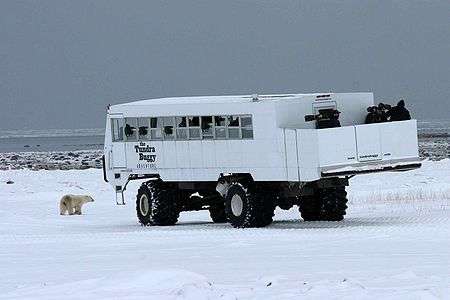Tundra Buggy

A Tundra Buggy, originally invented & built by Leonard D. Smith in 1979, is an all-terrain vehicle used to view, photograph and study polar bears, in the Cape Churchill Wildlife Management Area, of Manitoba, Canada. Smith took his first trip on his Tundra Buggy to Cape Churchill in 1979 with a group of explorers and a 'National Geographic' film crew which created the movie "Polar Bear Alert". Smith also created a company he named "Tundra Buggy Tours" and went on to build 14 Tundra Buggies and The Tundra Buggy Lodge. The lodge consists of a diner, lounge, two bunkhouses, kitchen, muktuk saloon and utilities unit. It is towed from Churchill, Manitoba, behind the Tundra Buggy vehicles for several miles and connected together like units of a train, on the west shore of Hudson Bay.
Polar bears congregate every year along the shores of the bay, waiting for the freeze up and to feed on ringed seals. Leonard D. Smith received the Manitoba Tourism Innovation Award in 1989, and the Order of Manitoba in 2004, celebrating 25 years of the operation of Tundra Buggy Tours.[1] In the year 2000 Smith sold Tundra Buggy Tours to Frontiers North Adventures, Winnipeg, Manitoba, Canada.
Frontiers North Adventures now operates Tundra Buggies as a wildlife viewing vehicle for photographing and observing polar bears and other sub-Arctic wildlife outside of Churchill, Manitoba in the Churchill Wildlife Management Area and Wapusk National Park in northern Canada. Churchill is known as the "Polar Bear Capital of the World".[2] To date, 17 vehicles have been produced and are used by researchers and tourists.[3] The term "Tundra Buggy" is a registered trademark of Frontiers North Adventures.
Tundra Buggies are built very high off the ground to ensure guest safety. Before the autumn freeze, these vehicles only use an existing set of trails on the tundra that were built by the Canadian and American Armed Forces in the 1950s and 1960s. The high ground clearance of the Buggies also help navigate through difficult areas of the trail. The Tundra Buggy fleet is now custom built and manufactured by Frontiers North Adventures in Churchill, Manitoba.
The average male polar bear is 8 to 10 feet (2.5 to 3 meters) tall when standing on its hind legs. The tires on each Tundra Buggy vehicle are 5.5 feet (1.7 meters) high and 3.6 feet (1.1 meters) wide, and sit on 25-inch rims. A wide-bodied enclosure sits on top of the wheels and provides even more height, security, comfort and ability for guests to move around to view and photograph wildlife. The engine in Tundra Buggies is an International DT 466, often found in highway semi-trailers. It is geared through the Allison Transmission, and then geared through the differentials and planetaries on the hubs. The buggies are full-time four-wheel drive and have the capability to lock the differentials if needed.
The top speed of a Tundra Buggy is approximately 45 km/h (28 mph) on a smooth trail, but usually travels much slower. The Buggies are relatively self-sufficient with onboard air compressors, tool kits, extra fluids and oils, lavatories and propane heaters which are independent of the engine. As well Tundra Buggies include comfortable seats, windows that open and a large observation deck.
Tundra Buggies can also tow additional modules containing bunks, showers, and dining facility for overnight stays on the tundra in a configuration the company calls a "Tundra Buggy Lodge".[4]
References
- ↑ "Members of the Order of Manitoba".
- ↑ "Eight places to visit while you can". Macleans. October 8, 2009. Retrieved 2009-10-11.
- ↑ "Mom, Where do Tundra Buggies come from?". Frontier North Adventures. Retrieved 2009-10-11.
- ↑ Mulvaney, Kieran (September 13, 2009). "Arctic Blast, For a couple of months in Churchill, Manitoba, the polar bears come calling". Washington Post. Retrieved 2009-10-11.